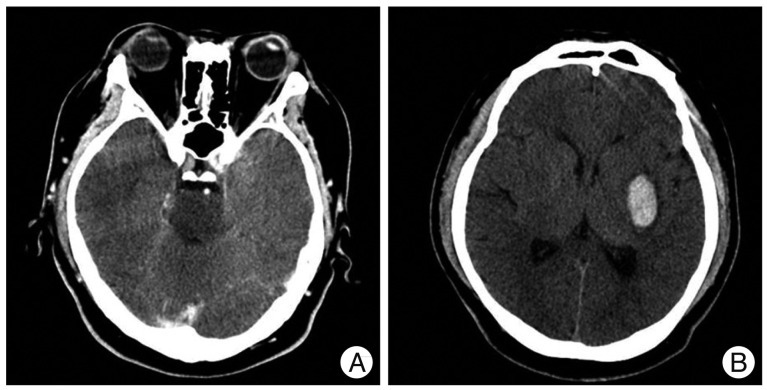J Korean Neurosurg Soc.
2013 Aug;54(2):139-141. 10.3340/jkns.2013.54.2.139.
Hypertensive Encephalopathy with Reversible Brainstem Edema
- Affiliations
-
- 1Department of Neurosurgery, Seoul National University College of Medicine, Seoul, Korea.
- 2Department of Neurosurgery, The Armed Forces Capital Hospital, Seongnam, Korea.
- 3Department of Neurosurgery, The Catholic University of Korea, Bucheon St. Mary's Hospital, Bucheon, Korea. armada1997@naver.com
- KMID: 1814253
- DOI: http://doi.org/10.3340/jkns.2013.54.2.139
Abstract
- Presented here is a 36-year-old male with arterial hypertension who developed brainstem edema and intracranial hemorrhage. Magnetic resonance scan revealed diffuse brainstem hyperintensity in T2-weighted and fluid-attenuated inversion-recovery images, with an increase in apparent diffusion coefficient values. After a reduction in blood pressure, rapid resolution of the brainstem edema was observed on follow-up. The patient's condition was thus interpreted as hypertensive brainstem encephalopathy. While many consider this a vasogenic phenomenon, induced by sudden, severe hypertension, the precise mechanism remains unclear. Prompt recognition and aggressive antihypertensive treatment in such patients are essential to prevent permanent or life-threatening neurologic injury.
Keyword
MeSH Terms
Figure
Reference
-
1. Bartynski WS. Posterior reversible encephalopathy syndrome, part 2 : controversies surrounding pathophysiology of vasogenic edema. AJNR Am J Neuroradiol. 2008; 29:1043–1049. PMID: 18403560.
Article2. Chang GY, Keane JR. Hypertensive brainstem encephalopathy : three cases presenting with severe brainstem edema. Neurology. 1999; 53:652–654. PMID: 10449143.
Article3. Chen TY, Lee HJ, Wu TC, Tsui YK. MR imaging findings of medulla oblongata involvement in posterior reversible encephalopathy syndrome secondary to hypertension. AJNR Am J Neuroradiol. 2009; 30:755–757. PMID: 18854436.
Article4. Doi Y, Kimura F, Fujiyama T, Fujimura C, Nishina T, Sato T, et al. Hypertensive brainstem encephalopathy without parieto-occipital lesion--two case reports. Neurol Med Chir (Tokyo). 2006; 46:75–79. PMID: 16498216.
Article5. Garg RK. Posterior leukoencephalopathy syndrome. Postgrad Med J. 2001; 77:24–28. PMID: 11123390.
Article6. Hinchey J, Chaves C, Appignani B, Breen J, Pao L, Wang A, et al. A reversible posterior leukoencephalopathy syndrome. N Engl J Med. 1996; 334:494–500. PMID: 8559202.
Article7. Ijima T, Kubota Y, Kuroiwa T, Sankawa H. Blood-brain barrier opening following transient reflex sympathetic hypertension. Acta Neurochir Suppl (Wien). 1994; 60:142–144. PMID: 7976528.
Article8. Legriel S, Pico F, Azoulay E. Understanding Posterior Reversible Encephalopathy Syndrome. Ann Upd Intens Care Emerg Med. 2011; 1:631–653.
Article
- Full Text Links
- Actions
-
Cited
- CITED
-
- Close
- Share
- Similar articles
-
- Two Cases of Hypertensive Encephalopathy Involving the Brainstem
- Hypertensive Brainstem Encephalopathy Combined with Acute Ischemic Stroke
- Reversible Obstructive Hydrocephalus Associated with Hypertensive Brainstem Encephalopathy
- Predominant Hypertensive Brainstem Encephalopathy with Supratentorial Involvement: Case Report and Literature Review
- Reversible Pontine MRI Lesion in Acute Thalamic Infarct: Reversible Encephalopathy due to Hypertension?



